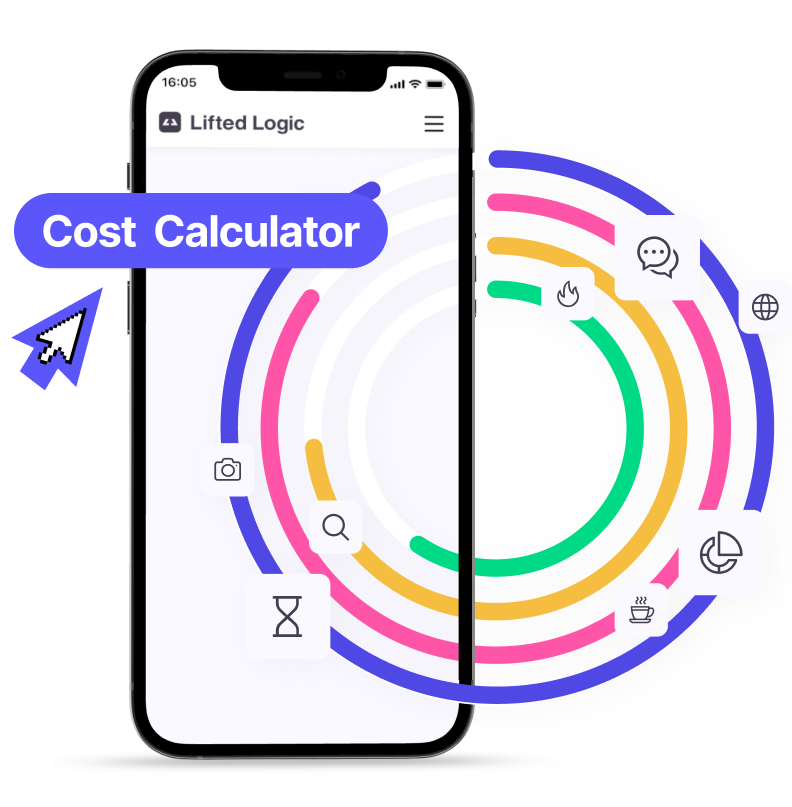Budgets aren’t ever unlimited, and marketers don’t always get to choose their limit. So how can you maximize the budget you have and decide what types of marketing spend are worth it and how much money to spend? We’re here to tell you.
At Lifted Logic, we help businesses from all industries and all over the country make smart, ROI driven, goal-oriented decisions about where their marketing dollars are best spent. We are experts in web design, development, and digital marketing strategies like SEO, paid advertising, and more. We can tell you what works—and what doesn’t—because we’ve done it.
Let us walk you through our thought process when considering marketing spend:
Step 1: define your goals
In marketing, your #1 priority should be to define your goals.
In the short term, what are you hoping to achieve? This could be increasing brand awareness, increasing lead volume, or driving RSVPs for an event.
Long-term business goals might be bigger and require more planning, like opening a new location or growing a client base for a new service.
Both short-term and long-term goals can be achieved through marketing, but the timeline will alter the strategy you choose and how much of your marketing spend you can allocate.
💡 For example, if you’re marketing goal is to get more people to sign up for your holiday event, a newsletter or email blast is a low-cost strategy to help you achieve that short-term goal.
If your long-term goal is to grow your team, you could make a plan or hire someone for consistent SEO blogging to increase lead volume from your website. More leads → more clients → demand for more employees.
What goes hand-in-hand with defining your goals? Setting clear expectations. Whether it’s with your digital marketing agency or with your internal team, outline which KPIs are most important in tracking your progress and what progress you expect to make.
Step 2: consider all the factors
Other factors to consider when deciding what marketing strategy you need and how much to spend require a bit of competitive analysis. Just as much as you need to know what your objectives are, you need to know your surroundings and what you’re up against.
Where are you located?
Trying to sell coats and outerwear in Canada will look completely different than in New Mexico. Considering your location means inferring how people in your area might respond to what you’re offering. That naturally will influence how you speak to them about it.
Sticking with our previous example, Canada is probably a significantly more competitive market for coats, which means you will need to pay extra attention to what your competitors are doing and how you can stand out.
What industry are you in?
Your industry can impact your marketing spend choices based on competition and also seasonality. If you have a busy season, your marketing spend should probably increase during that time of year.
And just to play devil’s advocate—maybe the busy season for you is also the busy season for your clients. Then you may consider beefing up your marketing efforts in the off-season when you’re more likely to grab and hold their attention.
What do you know about your target audience?
Who are they? Where do they spend their time? Where might they be in the buying cycle? These are the basic things you need to know about your audience to predict how expensive they might be to target.
If your target audience is younger, it might make more sense to target them on social media. Speaking generally, social media advertising is less expensive than Google advertising.
If your target audience is narrowed to one specific geographic location, that will affect your marketing spend. Marketing to people in Lincoln, Nebraska, would be significantly cheaper than marketing to people in Chicago—the market may be more saturated, there are more people, and there are probably more competitors.
What is the level of competition?
Speaking of competition, operating in a super competitive market will increase the cost of marketing for everyone, not just you. This is partly to do with saturation—the number of people trying to sell products or services in that space—and partly to do with the quality of your marketing deliverables.
For example, when you’re employing SEO, optimizing for a keyphrase that is more competitive means you need to work harder to create quality content that considers:
- The length of your content
- Your domain authority
- The external and internal linking opportunities
- The user intent
Inversely, if you can find a keyphrase with the same user intent—the question they are intending to answer with their search—but is less competitive, you have a better shot at achieving your goals.
Step 3: choose your digital marketing strategy
To illustrate all of these factors in motion, let’s talk through two of the most popular digital marketing strategies when it comes to websites.
Search Engine Optimization (SEO)
To keep it simple, search engine optimization is a way to increase your web traffic through organic search results. Based on that definition, there is one clear goal: increasing web traffic.
But the key is it needs to be a balance between quality and quantity. You could attract all the users in the world, but if they aren’t the users you need, then it’s a waste.
Your website is your brand’s only sales representative that works 24 hours a day. If you have an online presence designed to attract customers and drive business (which you should), you need SEO that is written to convert users into customers.
Your SEO-powered website also acts as the strong foundation for the rest of your digital marketing. Every avenue you pursue, from email campaigns to publishing articles, should be driving traffic back to a website that is equipped with relevant content.
Why SEO works and how to tell when it is →
Pay Per Click (PPC) advertising
Pay per click, sometimes referred to as cost per click (CPC), refers to any digital paid advertising campaign that charges fees per click.
This model is especially popular through Google’s advertising platform: Google Ads, although it’s used by many social media platforms as well.
Say you’re advertising for golf clubs in Kansas. Whenever someone in Kansas searches “golf clubs,” you want to be the first advertisement on the results page. If the user clicks on your ad, Google will charge you the amount that they bid for you to show up on the results page.
Some like to think of SEO vs. PPC as simply long-term vs. short-term, but this is only a piece of pie. While PPC can have a much quicker results turnaround than SEO, it’s not immediate.
There is always an element of strategy and planning ahead, even with pay per click 🤯
PPC can be an effective means to:
- Break into a new market
- Expand into a different geographic area
- Promote a new service
- Increase brand awareness
- Target a more niche audience
- Re-market to your website users
- And more
How SEO & PPC can work together
SEO and PPC are two great examples of marketing strategies that play nice together. Considering both your long and short-term goals, there is probably a place for both.
Think of your website like a concert. SEO is the headliner. The breadwinner. What the people want. PPC is like the opening act. They’re great—you couldn’t have attracted as many people without them—but their true task is to warm up the crowd. PPC is the short-term solution to the long-term problem that strong SEO eliminates.
More about how the best digital marketing strategies include both PPC and SEO →
The only caveat to this analogy is that PPC can only be successful if you’re sending advertisement traffic to a website or page with strong SEO. Page performance and landing page experience are huge factors in the strength of your campaigns.
In terms of marketing spend, we like to imagine these two on a teeter-totter (cute, right?). If you’re working to improve your SEO, it can take time. PPC, like search ads, can be an impactful supplement to your marketing efforts while your content indexes with Google and starts to rank.
Once you’re ranking organically, you shouldn’t need to also pay for the ad space on that results page, so the teeter-totter (your marketing spend) should slowly begin to shift over little by little.
Other strategies
SEO and PPC are just two examples of many different marketing strategies you can employ to achieve your business goals:
- Social media marketing
- Influencer marketing
- Affiliate marketing
- Email marketing
More often than not, strategies can and should be used in conjunction with one another. It’s like trying to build muscle. Working out is the top-tier strategy to bulk up, but your diet is also going to make a major impact.
Step 4: consider your ROI
So, where does your budget come in? When we talk about marketing spend, we know that we’re really talking about ROI, but how do you track your progress and hold yourself and your marketing team accountable?
Lifetime value of a client
How much you spend on marketing will vary depending on your strategy, budget, and timeline, but your decisions should always weigh against the lifetime value of a single client.
A great example is your hairdresser. If you pay $100 to get your hair done, but you go 3 times a year for 5 years, you’re not just worth the $100 appointment; you’re worth the $15,000 you’ve paid in total.
When you plan your marketing spend long term, you need to consider how much a client is worth to you across their entire relationship with your business, not just the first encounter. How much you spend on an individual lead should directly correlate to their value to you. That means your lead acquisition strategies and also your internal process for managing, converting, and nurturing leads.
Step 5: understand your bandwidth
So, you’ve chosen a strategy and a budget. Do you have a plan to get the job done? Depending on the size and structure of your internal marketing team and the components of the strategy you’ve chosen, it’s important to be realistic about what you have the bandwidth to accomplish.
There is no shame in asking for help! It’s difficult to be good at content writing, digital design, marketing strategy, and web development all at once. Sometimes the smartest decision can be to find a marketing partner who can fill in the gaps.
You don’t know what you don’t know. Delegating is a skill and putting it into practice requires practice. If you can get good at letting the specialists do what they’re good at, whether they are external or internal, it will save you time and better your results—and those things make you more money. Don’t let inexperience be what costs you.
Partner with Lifted Logic to maximize your marketing ROI
If you’re ready to speak to a professional, we’ve got your back. Whether you’re looking for someone to manage your marketing efforts or just a partner in creating a plan, let’s talk!




